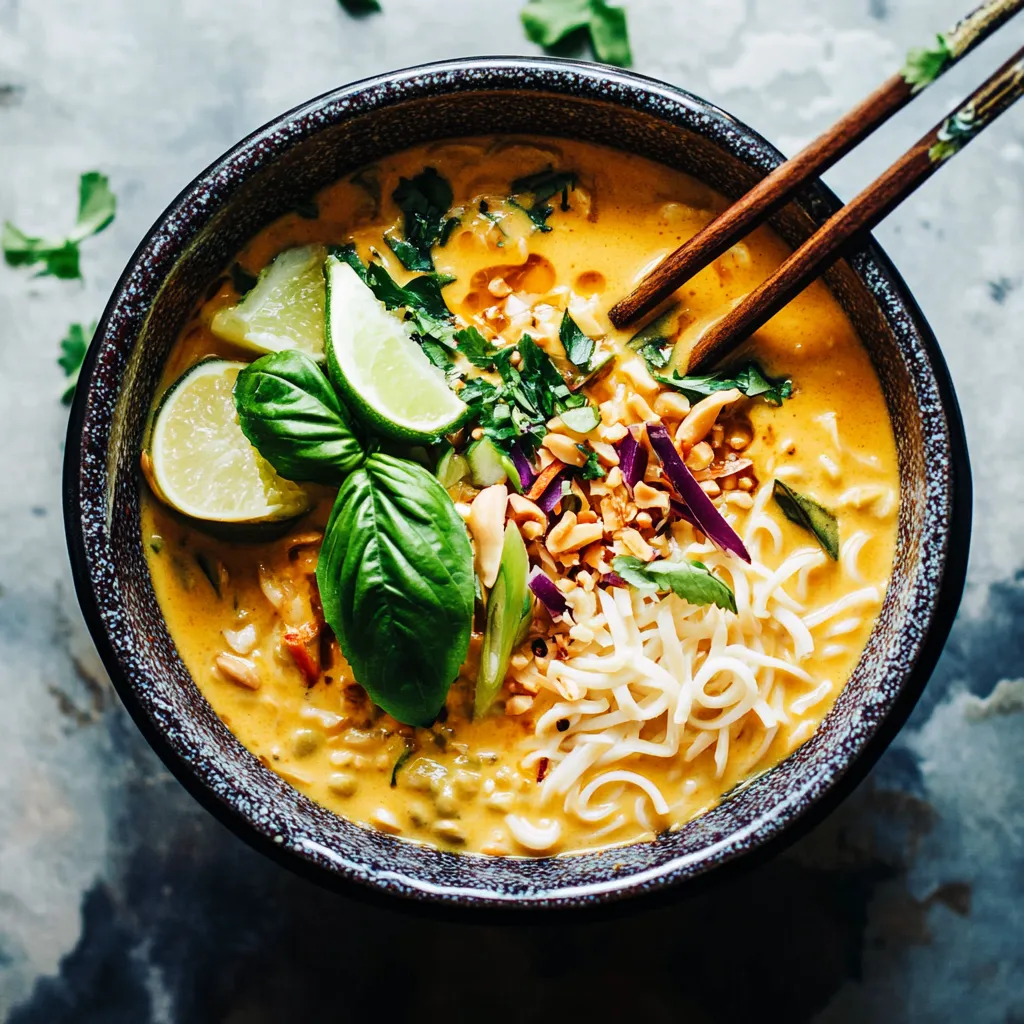 Save
Save
This vibrant coconut curry noodle bowl has been my weeknight dinner savior for years. The creamy coconut broth infused with aromatic red curry paste creates a silky bath for tender rice noodles and crisp vegetables, delivering restaurant-quality flavor in just 30 minutes.
I first created this recipe during a busy work week when I needed something quick but was craving Thai takeout. Now it's become our Monday night tradition after my farmers market runs, using whatever produce looks freshest.
Ingredients
- Rice noodles: Create the perfect base to soak up the curry sauce use thin or medium width depending on your preference
- Full fat coconut milk: Provides the signature creamy richness don't substitute with light coconut milk
- Red curry paste: Delivers complex Thai flavors in seconds look for authentic brands like Mae Ploy or Maesri
- Fresh ginger and garlic: Form the aromatic foundation always use fresh not powdered for bright flavor
- Colorful vegetables: Add nutrition and texture choose firm varieties that hold up to simmering
- Lime juice: Brightens the entire dish with essential acidity added at the end to preserve freshness
- Brown sugar: Balances the spice with subtle sweetness palm sugar can be substituted for more authentic flavor
- Soy sauce or tamari: Adds savory depth and saltiness use tamari for a gluten free option
Step-by-Step Instructions
- Cook the Noodles:
- Bring a large pot of water to a rolling boil then add rice noodles. Cook according to package instructions usually 6 to 8 minutes until al dente. Immediately drain and rinse under cold water to stop cooking and prevent sticking. This timing is crucial as overcooked noodles become mushy in the curry.
- Create the Aromatic Base:
- Heat coconut oil in a large deep skillet or Dutch oven over medium heat until shimmering but not smoking. Add thinly sliced onions and cook for exactly 3 to 4 minutes stirring occasionally until they become translucent and soft. Add minced garlic and ginger cooking for precisely 1 minute more while stirring constantly to prevent burning. This aromatic foundation flavors the entire dish.
- Bloom the Curry:
- Add red curry paste and curry powder directly to the aromatics and stir constantly for 60 seconds. This crucial step allows the oil to bloom the spices releasing their essential oils and intensifying the flavor profile. The mixture should become fragrant and slightly darker.
- Develop the Broth:
- Pour in the coconut milk slowly while whisking to incorporate the curry paste completely. Add vegetable broth soy sauce and brown sugar stirring until dissolved. Bring to a gentle simmer not a rolling boil to prevent the coconut milk from separating. This creates your silky curry base.
- Cook the Vegetables:
- Add the firmer vegetables first bell peppers and broccoli followed by quicker cooking carrots and cabbage. Simmer for exactly 5 to 7 minutes until vegetables are tender crisp. Maintaining some texture in the vegetables provides crucial contrast to the soft noodles.
- Combine Components:
- Gently fold the cooked noodles into the simmering curry broth ensuring they are fully submerged to absorb the flavors. Immediately squeeze fresh lime juice over everything and fold again to distribute. The acid from the lime brightens all flavors and balances the richness.
- Serve with Style:
- Ladle the curry noodles and plenty of broth into deep bowls. Top generously with fresh cilantro green onions and your desired level of sriracha. Serve immediately while steaming hot with extra lime wedges on the side.
This recipe reminds me of my travels through Thailand where I first fell in love with the balanced complexity of Thai curries. The secret I learned from a cooking class in Chiang Mai was toasting the curry paste in oil before adding any liquids. This simple step transformed my homemade curries forever.
Protein Additions
For a more substantial meal, protein options blend seamlessly into this curry. For tofu, press firm tofu for 30 minutes, cube it, and pan-fry until golden before adding to the finished curry. Shrimp cooks quickly in just 3-4 minutes in the simmering broth right before serving. For chicken, sliced boneless thighs should be cooked directly in the curry liquid for 8-10 minutes until fully cooked through.
Make Ahead Strategy
This curry noodle bowl separates beautifully into components for meal prep. Prepare the curry broth and store refrigerated for up to 3 days. Cook vegetables but keep them slightly underdone, storing separately. Prepare rice noodles but rinse with cold water and toss with a tiny bit of oil to prevent sticking. When ready to serve, simply reheat the broth, add the vegetables to warm through, then add the noodles just before serving.
Vegetable Variations
The beauty of this recipe lies in its adaptability to seasonal produce. In spring, try asparagus, snow peas, and spinach. Summer calls for zucchini, yellow squash, and fresh corn kernels. Fall works wonderfully with butternut squash, mushrooms, and kale. Winter is perfect for sweet potatoes, cauliflower, and Brussels sprouts. Each variation creates an entirely new experience while maintaining the comforting curry base.
Cultural Context
While this recipe draws inspiration from Thai cuisine, it's an approachable fusion adaptation rather than strictly traditional. Authentic Thai red curry typically includes ingredients like galangal, lemongrass, and kaffir lime leaves. If you have access to these ingredients, adding them to the aromatic base elevates the dish to new heights of authenticity.
Frequently Asked Questions About Recipes
- → Can I use different vegetables in this dish?
Yes, you can substitute with veggies like zucchini, mushrooms, or snap peas. Use what you have on hand for a flexible and flavorful meal.
- → Can I add protein to the noodle bowls?
Absolutely! Add tofu, shrimp, grilled chicken, or even baked salmon for a protein boost that complements the flavors.
- → Can I make this dish spicier?
Yes, adjust the heat by adding more red curry paste, sriracha, or red pepper flakes to taste.
- → How do I store leftovers?
Store leftovers in an airtight container in the refrigerator. Reheat gently on the stovetop or microwave with a splash of vegetable broth to loosen the sauce.
- → Are these noodle bowls gluten-free?
If you use rice noodles and tamari instead of soy sauce, this dish is entirely gluten-free. Always double-check ingredient labels to confirm.
